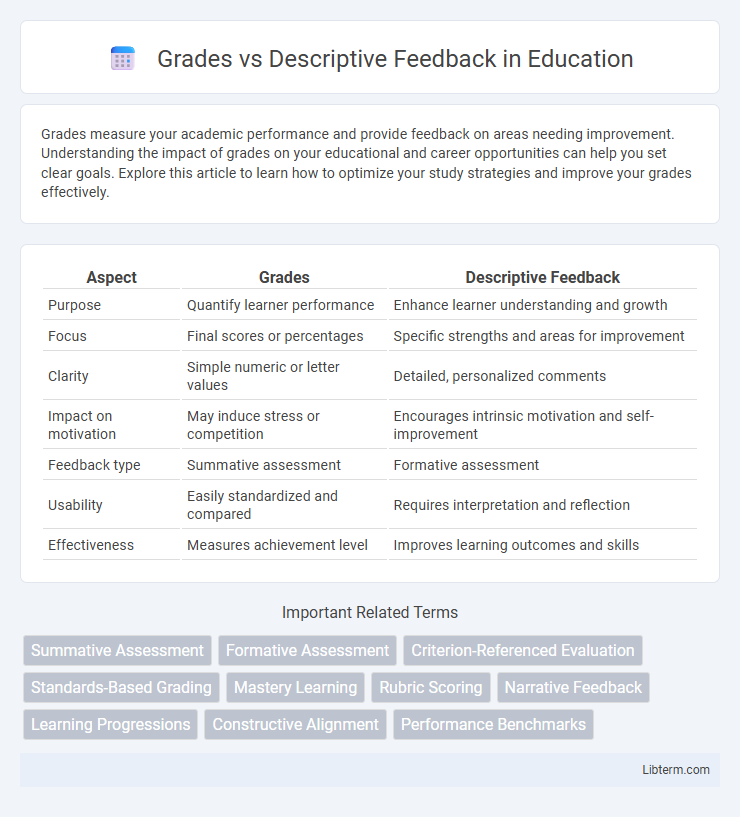Grades measure your academic performance and provide feedback on areas needing improvement. Understanding the impact of grades on your educational and career opportunities can help you set clear goals. Explore this article to learn how to optimize your study strategies and improve your grades effectively.
Table of Comparison
| Aspect | Grades | Descriptive Feedback |
|---|---|---|
| Purpose | Quantify learner performance | Enhance learner understanding and growth |
| Focus | Final scores or percentages | Specific strengths and areas for improvement |
| Clarity | Simple numeric or letter values | Detailed, personalized comments |
| Impact on motivation | May induce stress or competition | Encourages intrinsic motivation and self-improvement |
| Feedback type | Summative assessment | Formative assessment |
| Usability | Easily standardized and compared | Requires interpretation and reflection |
| Effectiveness | Measures achievement level | Improves learning outcomes and skills |
Introduction: Understanding Grades and Descriptive Feedback
Grades quantify student performance through standardized scoring systems, providing a clear metric for assessment. Descriptive feedback offers detailed, qualitative insights into a learner's strengths and areas for improvement, promoting deeper comprehension and growth. Combining both approaches can enhance educational outcomes by balancing objective evaluation and personalized guidance.
Defining Grades: Purpose and Limitations
Grades serve as standardized indicators of academic performance, offering quantifiable measures for assessment and comparison. Their primary purpose is to summarize student achievement efficiently, yet they often fail to capture the nuances of individual learning processes and conceptual understanding. Limitations of grades include a lack of personalized insights, potential to encourage surface learning, and insufficient guidance for improvement compared to descriptive feedback.
What Is Descriptive Feedback?
Descriptive feedback provides specific, detailed information about student performance, highlighting strengths and areas for improvement rather than assigning a numerical or letter grade. It emphasizes actionable guidance that helps learners understand the learning process and develop skills more effectively. Unlike traditional grades, this form of feedback supports deeper engagement and fosters continuous growth by addressing individual learning needs.
Impact on Student Motivation
Descriptive feedback significantly enhances student motivation by providing specific guidance that fosters a growth mindset and encourages continuous improvement. Grades often create pressure and anxiety, leading to decreased intrinsic motivation and a focus on performance rather than learning. Research shows that students who receive detailed, constructive feedback are more likely to engage deeply with the material and persist through challenges.
Promoting Deep Learning: Grades vs Feedback
Descriptive feedback promotes deep learning by providing specific, actionable insights that help learners understand their strengths and areas for improvement, fostering critical thinking and self-regulation. In contrast, grades offer a summative evaluation that often emphasizes performance outcomes rather than the learning process itself. Emphasizing feedback over grades encourages students to engage more meaningfully with content, leading to sustained motivation and enhanced knowledge retention.
Teachers’ Perspectives on Assessment Methods
Teachers often view descriptive feedback as a more effective assessment method than traditional grades because it provides detailed insights into student progress and areas for improvement. This qualitative approach helps educators tailor instruction to individual learning needs, fostering deeper understanding and skill development. However, some teachers acknowledge that grades offer a standardized measure of performance that is easier to communicate to students, parents, and administrators.
Student Reactions to Grades versus Feedback
Students often experience increased anxiety and decreased motivation when receiving traditional grades, as numerical scores can feel impersonal and punitive. Descriptive feedback fosters a growth mindset by providing specific insights into strengths and areas for improvement, which helps students understand their learning process. Research shows that detailed feedback enhances student engagement and encourages active learning more effectively than grades alone.
Effects on Academic Performance
Descriptive feedback significantly enhances academic performance by providing specific, actionable insights that help students identify strengths and address weaknesses. Unlike traditional grades, which offer limited information on learning progress, descriptive feedback fosters deeper understanding and motivation, leading to improved retention and skill development. Research indicates that students receiving detailed feedback outperform peers who rely solely on grades, demonstrating higher engagement and achievement in complex tasks.
Implementation Challenges in Classrooms
Implementing descriptive feedback in classrooms faces challenges such as increased time demands on educators to provide detailed, personalized comments compared to traditional grading. Teachers often struggle with balancing curriculum pacing while delivering meaningful qualitative feedback that promotes student growth. Limited professional development on effective feedback strategies further complicates seamless integration within diverse classroom settings.
Moving Forward: Integrating Grades with Descriptive Feedback
Integrating grades with descriptive feedback enhances student learning by providing clear performance metrics alongside actionable insights for improvement. Descriptive feedback highlights strengths and specific areas needing growth, guiding students on how to move forward effectively. Combining both approaches supports a balanced assessment framework that motivates learners and fosters continuous academic development.
Grades Infographic

 libterm.com
libterm.com